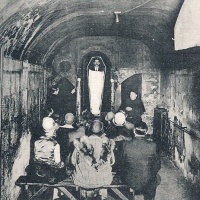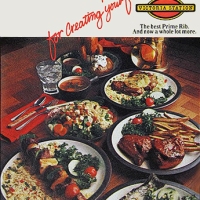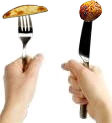 I’ve always thought it odd that anyone would think of fast food eateries as friendly. The tersely scripted counter help and the characteristically uncomfortable, bolted-down tables and chairs seem anything but hospitable to me. Of course, most patrons know and accept the terms of doing business with fast food chains whose low prices are predicated on providing minimal on-site facilities at which customers gulp their food, crumple their bags, and depart.
I’ve always thought it odd that anyone would think of fast food eateries as friendly. The tersely scripted counter help and the characteristically uncomfortable, bolted-down tables and chairs seem anything but hospitable to me. Of course, most patrons know and accept the terms of doing business with fast food chains whose low prices are predicated on providing minimal on-site facilities at which customers gulp their food, crumple their bags, and depart.
The fast food formula was first developed by turn-of-the-century “quick lunch” establishments. Like later chains they provided few amenities that might have encouraged lingering. Patrons sat in chair & table combos resembling one-armed school desks. No coat racks were provided so diners usually left their coats on. Just as well, because the spaces were so tight that someone removing his coat stood a good chance of sweeping his neighbor’s food onto the floor.
 The idea that patrons should not linger wasn’t really new even then. Mourning the passing of Brooklyn’s old-fashioned chop houses, a reporter noted in 1889 that chop houses had been replaced by restaurants “where all is hurry and bustle, and where he who lingers at the table after his bill has been paid is regarded as an incumbrance.”
The idea that patrons should not linger wasn’t really new even then. Mourning the passing of Brooklyn’s old-fashioned chop houses, a reporter noted in 1889 that chop houses had been replaced by restaurants “where all is hurry and bustle, and where he who lingers at the table after his bill has been paid is regarded as an incumbrance.”
It’s not clear whether quick lunch proprietors plotted their interiors with an eye to turnover, but certainly by the 1920s restaurant managers were well aware that turning tables faster could increase profits. Suddenly even restful tea rooms were under pressure as they were thrust into competition with chain restaurants that used economies of scale to reduce costs and prices. Writing in 1929, Madeleine F. Wolf observed that if they wanted to survive, “The Dew Drop Inn, the Bide-a-Wee Tea Room, the Cheer-Up Cabin, must go on pretending an interest in each individual guest whereas their true interest lies in numbers.”
 Brisk modern style, in the form of cubist decor and streamlined furniture, provided assistance in the late 1920s and 1930s. Artist and industrial designer John Vassos, who illustrated the book Phobia, felt he understood psychology well and successfully applied it in his 1931 design of NYC’s Rismont Tea Room, where the tables were a bit too small and chair seats were triangular. “The chairs are comfortable – if one doesn’t sit too long on them,” he wrote. [see photo]
Brisk modern style, in the form of cubist decor and streamlined furniture, provided assistance in the late 1920s and 1930s. Artist and industrial designer John Vassos, who illustrated the book Phobia, felt he understood psychology well and successfully applied it in his 1931 design of NYC’s Rismont Tea Room, where the tables were a bit too small and chair seats were triangular. “The chairs are comfortable – if one doesn’t sit too long on them,” he wrote. [see photo]
Uncomfortable chairs would become known in the restaurant industry as “15-minute chairs.” Charles Eames’ fiberglass scoop chair (shown above) might be an example, offering little possibility of posture realignment.
 Bright lights, loud colors, and loud music also discourage coffee refills and relaxed conversation, often quite deliberately. In the Forum Cafeteria in Kansas City MO in the 1960s walls with stripes in mist, olive, turquoise, blue, and white were deemed perfect for that “friendly, but not too friendly” effect. Nooks decked out with red banquettes and red carpeting, likewise, whispered “goodbye,” as did armless turquoise chairs.
Bright lights, loud colors, and loud music also discourage coffee refills and relaxed conversation, often quite deliberately. In the Forum Cafeteria in Kansas City MO in the 1960s walls with stripes in mist, olive, turquoise, blue, and white were deemed perfect for that “friendly, but not too friendly” effect. Nooks decked out with red banquettes and red carpeting, likewise, whispered “goodbye,” as did armless turquoise chairs.
If all else failed to dislodge the diner, the server could always lean over and ask, “Can I get you anything else?” – or “All set?” as they so bluntly say in New England.
© Jan Whitaker, 2012












 It's great to hear from readers and I take time to answer queries. I can't always find what you are looking for, but I do appreciate getting thank yous no matter what the outcome.
It's great to hear from readers and I take time to answer queries. I can't always find what you are looking for, but I do appreciate getting thank yous no matter what the outcome.



Pingback: Mary Browns, Popeyes Chicken - Dining with Donald
Pingback: Mary Browns, Popeyes Chicken - Dining with Donald
Pingback: Mary Browns, Popeyes Chicken – Dining with Donald
Pingback: Fact of the Day - Interesting Facts Of The Day - Daily Facts | KickassFacts.com
Pingback: 15 Minute Chairs | The Mighty Blog
Pingback: 15 Minute Chairs | The Mighty Blog
Pingback: Eat and run, please! | clusterflock
I have to disagree with your comments about the Eames’ chair you mentioned. I sat in it through countless hours of bridge, study, coffee, and telling stories (lying) in college. The Eames’ wanted inexpensive, but they didn’t want uncomfortable. They pioneered, and others slightly changed the design, and one couldn’t sit it’em. Compare the difference in your two pictures of fiberglass chairs.
Actually, I agree with you. It is the chairs inspired by Eames that are uncomfortable for long-term sitting.
It isn’t only restaurants that often have uncomfortable dining table chairs. We all need to think about the comfort of our guests when we choose chairs, not only aesthetics.